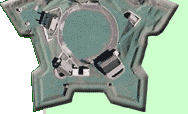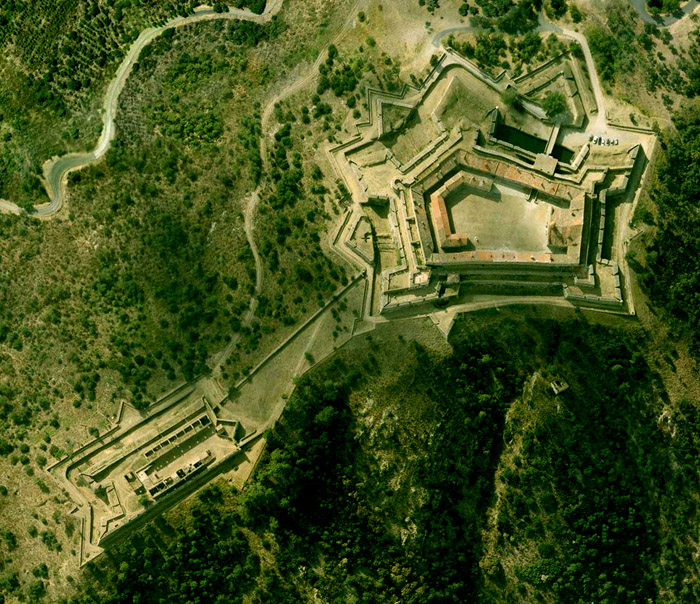
 |
 |
Fort Bellegarde Le Perthus, France |
 |
 |
 |
 |
 |
||
 |
During the Thirty Years' War (1618-1648), France and Spain did various mean things to each other...mostly after 1640, when France aided a revolt in Catalonia in Spain, and Spain in turn aided the Fronde revolt in France in 1648. The lands that France gained through negotiation for the Treaty of Westphalia (1648), which ended the Thirty Years' War, cut off Spain's access to the Netherlands and led to open warfare between France and Spain. After ten more years of war, an Anglo-French alliance defeated Spain at the Battle of the Dunes (1658), and the Treaty of the Pyrenees was signed in 1659, ending the French-Spanish conflict and redrawing the border between the two nations. The little town of le Perthus in the Pyrenees was a new French acquisition, right on that new border. A medieval castle called Castrum de Bellaguarda sat on a mountain overlooking the town and the border, and after a Spanish raid in 1668, the French began to fortify this position. Fortified medieval tower or not, the Spanish captured what was now known as Bellegarde in 1674 and set about improving the position to their own ends in 1675, but the French swept back in and recaptured the fort that same year. In 1678, Vauban got involved, a sure sign that France was now serious about fortifying Bellegarde. Vauban, who remarked that "nothing overlooks this place," designed a strong pentagonal fort with a detached hornwork, visible to the left in the picture above. The hornwork, which pokes right to the edge of the Spanish border, was connected to the rest of the fort by means of a covered way, which was a defensible position in itself: There are cannon embrasures in it. This inclusion was unusual, since such cannon could be turned against the fort's defenders. Spain declared war on Revolutionary France after King Louis XVI (1754-1793) and Queen Marie Antoinette (1755-1793) were guillotined in 1793. The War of the Pyrenees (1793-1795) saw a successful Spanish siege of Bellegarde from May to June of 1793, and then the French returning the favor of besiegement from May to September of 1794, reclaiming the fort once again. As seems to be the case with many French fortifications during the Second World War (1939-1945), the Gestapo used Bellegarde as a prison for escaped prisoners of war and enemy agents. Today there are two museums on the fort's grounds, one featuring a form of modern art called Cuix Art (?!). Bellegarde is reportedly explorable for a fee. |
 |
 |
||
|
|
|||||||
Info Source 1 Info Source 2 Info Source 3 Info Source 4 Info Source 5 Info Source 6 Info Source 7 Thanks to Google Maps for the image! ©2010 starforts.com |
 |